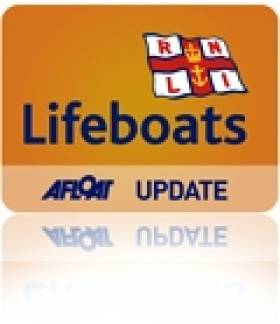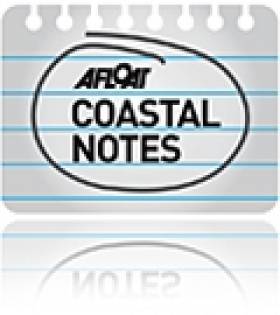Displaying items by tag: Larne Lough
Larne RNLI Assists Yacht While On Call-Out For Drifting Boat
#RNLI - While on exercise on Sunday morning (23 June 2013), Larne RNLI’s inshore lifeboat was requested to divert and investigate reports that a boat was drifting out to sea in Larne Lough.
The 11m wooden boat had nobody onboard and represented a hazard in the area.
As the volunteer lifeboat crew neared the vessel they noticed a man in a punt approaching them. The man was from a nearby boat and having become concerned at the drifting vessel, had decided to investigate and see if he could assist.
However it was discovered that his nine 9m yacht, which had another crew member onboard, had also got into difficulty and was starting to drag its mooring.
Wind conditions were force four to five with a north gusting wind and lumpy seas.
The inshore lifeboat assisted the man back onboard his vessel and a lifeboat crew member joined him. The dragging mooring was fixed and they were able to continue under their own power.
The original drifting boat was aground, and having made sure the other vessel and its two crew were safe, the lifeboat returned to assist. Establishing a tow, Larne RNLI inshore crew were able to gently pull the boat off the rocks.
They were then met by the all-weather lifeboat and the tow was passed on to them before it was safely secured on a mooring in Larne Lough and both lifeboats returned to station.
Commenting on the call-outs, Larne RNLI lifeboat operations manager Alan Dorman said: “What started as a normal Sunday morning exercise turned into a double call-out for both lifeboats.
"It shows how quickly things can change out at sea and the lifeboat is always available to assist and reassure. Thankfully on this occasion help was close at hand and no injury or damage was done.”
Larne RNLI Rescues Unconscious Man From Lough
#RNLI - Larne RNLI rescued an unconscious man who was found a short distance from the shore at Larne Lough last night (Thursday 20 June).
The volunteer crew launched their inshore lifeboat Hannahbella Ferguson following a request by Belfast Coastguard at 10.35pm to go to the assistance of a person who was spotted lying face down in the sea within 200 metres from the shore in Larne Lough.
Weather conditions at the time were good with a flat calm sea but light was fading.
The lifeboat - helmed by Willie Evans and with crew members Dave Somerville and Pamela Dorman onboard - arrived on scene at 10.41pm and pulled the casualty on to the lifeboat. With the man not breathing, two crew members proceeded to perform CPR and resuscitated the casualty.
The helm brought the lifeboat into a small slipway along the promenade which was accessible due to a high tide. The casualty was subsequently handed over to the waiting paramedics and ambulance.
Speaking after the call-out, Larne RNLI helm Willie Evans praised the crew who he said had worked together to resuscitate the casualty and bring him to shore.
New Northern Ireland Yacht Race for Meningitis Trust
The great circumnavigation of Larne Lough, a 'chase race' for Meningitis is a brand new event on the Irish sailing calendar. But what is it?
To be held on Saturday 7th September and hosted by East Antrim Boat Club, it is a type of pursuit race. However in reaching into every possible creek of the Lough, together with a variety of 'on-course hurdles,' it will be a race like no other. How many races have a built in roundabout to navigate? Overall it is a fundraising day drenched with fun, frolics and challenges.
Open to mono-hulled dinghies, day boats and sports boats with a Portsmouth Yardstick number between 900 and 1600 the day will actually consist of two races; one is for the juniors which will precede the main race. Both races will feature windward starts.
The driving force for the Meningitis Chase Race is the Jobling family. Tom and Jane lost their three-year-old grandson Stanley to Meningitis. The family are well known in competitive sailing circles but this is the first time that they have taken their fundraising campaigns afloat.
Tom Jobling said; "Stanley was always a fun loving boy, always joking, smiling so another boring old sailboat race wouldn't suit him at all. The day on Larne Lough will be full of surprises, both on and off the water. Stanley's dad Barry, himself a champion sailor will be delighted if our two key objectives can be achieved.' Tom's daughter Gemma continued, "We want at least 50 assorted boats out on the water and have raised £1,000 for the Meningitis Trust. And of course have remembered Stan's smile."
Information on the Meningitis Chase Race will filter out as the big day approaches but in the meantime call the Jobling family (tel) 0044(0)2827 6960 (091 from RoI) or look into www.thechaserace.co.uk Information is also available from the East Antrim Boat Club website; www.eabc.org.uk
Ireland to Get First 'Energy Bank' Beneath NI Lough
#COASTAL NOTES - The first ever 'energy bank' on this island will be constructed deep beneath a coastal lough in Northern Ireland, as the Irish Independent reports.
Some 500 million cubic metres of gas are set to be stored in salt caverns a mile under Larne Lough on the north Antrim coast, after NI Environment Minister Alex Attwood have his go-ahead for the project earlier today.
The Belfast Telegraph reports that site preparation work will begin before the end of this year on the expected seven-year construction scheme.
The €492.5-million gas storage facility is expected to hold a 60-day supply to create a buffer against increasing energy price rises.
"This security of supply of energy will be a significant step forward in the way we manage our energy sector," said Minister Attwood. "North Sea gas supplies are declining steeply and this facility will make a significant contribution to the security of gas supplies for the whole island of Ireland and indeed for Britain."
Meanwhile, environmentalists have voiced concerns over the planned disposal of salt from the caverns into the sea, and its potential to cause harm to marine wildlife and biodiversity.
Though Minister Attwood said he was conscious of environmental concerns, James Orr of Friends of the Earth argued that the dumping of hypersaline salt solution "will kill or be seriously detrimental to the development of larval stages of fish and crustaceans", and that Northern Ireland should rather be investing in renewable energy.
The Belfast Telegraph has more on the story HERE.
Details Sought on Noise Levels Over Proposed Larne Lough Gas Plant
#LARNE LOUGH - Larne Council has looked into the concerns of local residents over a proposed £250 million (€300 million) natural gas plant at Larne Lough, the Larne Times reports.
Islandmagee Storage Limited (IMSL) has applied for planning permission for a 500 million cubic metre natural gas storage facility in Permian salt beds almost a mile beneath the lough, which is claimed would satisfy the North's peak demand for gas for over 60 days.
But locals have spoken out with their fears over noise levels, health and safety, pollution and the potential effect on tourism in the area.
Larne Council’s environmental health department carried out its own research into the proposed facility, taking these concerns into consideration.
It found that there was "no huge issue in terms of noise levels" where similar facilities are established throughout the UK and that the effect on tourism would be negligable.
However the department was “not yet happy” with data supplied by IMSL regarding noise levels and would be seeking more detailed information.
The Larne Times has more on the story HERE.
Lost Larne Lough Fisherman 'Not Wearing Lifejacket'
An inquest into the death of a Larne man who drowned after his boat capsized in Larne Lough has heard that he and his fishing partner 'could not afford lifejackets'.
The News Letter reports that 29-year-old Graeme Nixon disappeared in the water when his small vessel seized and nosedived in Larne Lough. In land waterways.
His friend on board was able to swim to shore and raise the alarm, but Nixon's body was not recovered until two weeks later.
The court heard that a problem with an engine seal was the cause of the seizure, which would have been prevented by servicing.
Nixon was returning from fishing for whelks with John Kyle in a heavily laden boat when the accident occurred, just 200 metres from the shore.
The deceased father-of-two had been eager to pay for his upcoming stag night and a planned Christmas trip to New York for his fiancée.

































































